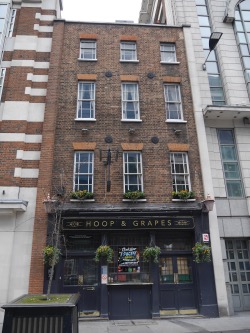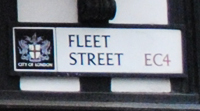This historic pub in Farringdon bears a common enough name (and it’s not to be confused with the Hoop and Grapes located in Aldgate which we’ll look at in an upcoming post).

The hoop in the name refers to the metal bands binding together barrels staves and the grapes are obviously a reference to wine. But the ‘hoop’ could be a corruption of hops with the sign possibly once featuring a garland of hops and a bunch of grapes.
The pub, the current sign of which depicts grapes wrapped around a hoop (pictured below), is located in a four storey building first constructed for a vintner in about 1720 as a terraced house and converted to a pub more than a century later in the early 1830s.
Located on ground which one formed part of the St Bride’s Burial Ground, the brick vaults underneath are said to pre-date the rest of the building, having been built as warehouse vaults in the 17th century.
Its location on 80 Farringdon Street means it stood near the Fleet River (now covered) and close by to the former Fleet Prison (largely used as a debtor’s prison before its demolition in 1864).

As a result, it has been claimed that it was one of a number of pubs which hosted so-called ‘Fleet Marriages’, secret ceremonies performed by dodgy clergymen – for a fee – and without an official marriage license. But, as has been pointed out to us, the timing of the passing of the Marriage Act in 1753 outlawing such activities – and this only becoming a pub, according to its Historic England listing, much later – does make this seem unlikely (we’d welcome any further information on this claim).
The location also meant it was popular with printers who worked in nearby Fleet Street (in fact, it was apparently given a special licence to serve such customers at night or in the early morning).
The pub was scheduled for demolition in the early 1990s but saved with a Grade II-listing in 1991.
A rare survivor from an earlier time among the street’s more modern buildings, it is now part of the Shepherd Neame chain and it’s during renovations held after this purchase that burials were uncovered (the remains were moved into the British Museum). This has apparently led to rumours that the pub is haunted.
For more, see www.hoopandgrapes.co.uk.
Sorry for the confusion – We’ve corrected references to grapes in the second paragraph (and amended our comments on the current sign). And we’ve also clarified comments that the pub was used for Fleet Marriages given the timing discrepancy.

